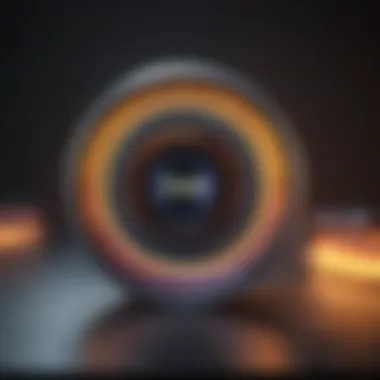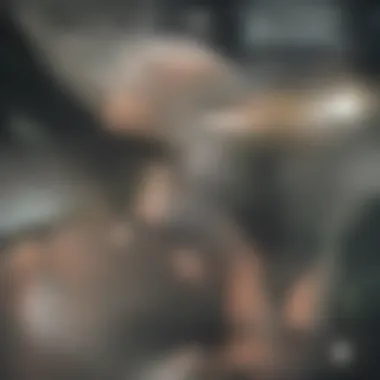Exploring the Wavelength of UVC: Significance & Uses


Intro
Ultraviolet light, particularly the UVC range, is an area of growing interest in fields such as health, environment, and technology. UVC wavelengths, ranging from 200 to 280 nanometers, are known for their germicidal properties. Understanding the implications of these wavelengths opens doors to various applications, from sterilization in healthcare to water purification in environmental science. This article explores these aspects, offering insights that connect scientific principles with practical applications.
Key Concepts and Terminology
Definition of Key Terms
- UVC Light: A type of ultraviolet radiation that is effective at inactivating microorganisms.
- Germicidal Wavelengths: Specific wavelengths within the UVC range that kill bacteria and viruses.
- Sterilization: The process of eliminating all forms of life, including bacteria, viruses, and spores.
- Disinfection: A process that reduces the number of pathogens on a surface or in a substance to a safe level.
Concepts Explored in the Article
This article discusses the characteristics of UVC light, its interaction with biological organisms, and the technical applications it supports. Key points include:
- The mechanism of action by which UVC light inactivates microorganisms.
- The benefits of UVC in health care settings, including its effectiveness against pathogens.
- The use of UVC in environmental applications, like water treatment.
- Safety measures and regulatory considerations related to UVC exposure.
Findings and Discussion
Main Findings
Recent studies highlight several significant findings regarding UVC wavelengths:
- UVC light is proven to be highly effective against a range of pathogens, significantly reducing infection rates in various medical environments.
- Environmental applications of UVC, such as in air and water purification, demonstrate potential for combating larger public health issues.
- Increased interest in UVC technology has prompted advancements in devices like UVC surface disinfectors and air purifiers.
Potential Areas for Future Research
While current applications are promising, further research is necessary to explore:
- Long-term effects of UVC exposure on different materials and surfaces.
- The potential development of UVC technologies that are safer and more efficient.
- Wider implications of UVC technology in public health policy and practice.
"Understanding the implications of UVC light not only benefits scientific communities but also enhances everyday life through improved public health practices."
In summary, a thorough understanding of UVC wavelengths is crucial. This knowledge enables researchers, educators, and professionals to apply UVC effectively, ensuring safety while harnessing its capabilities.
Prelude to UVC
Understanding UVC light is crucial given its significant implications in multiple domains such as health, environmental science, and technology. UVC light refers to a specific range of ultraviolet radiation, which has gained attention due to its unique properties and effects. This section unravels the core aspects of UVC, providing a foundation for comprehension of its broader implications.
Definition of UVC Light
UVC light is a segment of the ultraviolet spectrum, specifically ranging from 100 to 280 nanometers. It is categorized as a short-wave radiation type. UVC is distinct from other types of ultraviolet radiation, namely UVA and UVB, because of its capacity to destroy microbes and various pathogens. This property makes it valuable in the context of disinfection and sterilization. Furthermore, UVC light is not naturally present in sunlight, as the ozone layer absorbs most of it. This necessitates specialized equipment to harness its effects effectively.
Characteristics of UVC Radiation
Wavelength Range of UVC
The wavelength range of UVC, sitting between 100 and 280 nanometers, defines its interaction with biological organisms. One key characteristic of this range is its energy, which is significantly higher than both UVA and UVB radiation. This high energy enables it to penetrate the cell structure of microorganisms effectively, leading to the disruption of DNA molecules.
This characteristic is advantageous for applications in sterilization and disinfection, making UVC a popular choice for environmental health solutions. However, exposure to UVC light is harmful to human tissue which is a serious consideration.
Physical Properties
The physical properties of UVC are pivotal in understanding how it acts within different environments. UVC has a lower penetration depth compared to other types of UV radiation; hence, it mainly affects surface organisms and is more effective in air and water purification. Its capacity to be absorbed by organic materials is both an advantage and a limitation; it allows for targeted disinfection but also demands that surfaces be free from dust or other obstructions for optimal efficacy.
The unique properties of UVC make it a valuable tool in contemporary health and environmental applications, yet caution is critical when dealing with exposure risks, such as skin and eye damage. Its utility must be balanced against safety measures, guiding both its application in technology and regulatory standards.
Wavelength Spectrum


The wavelength spectrum is a foundational concept in understanding ultraviolet (UV) light, particularly UVC. This section highlights the significance of UVC within the broader electromagnetic spectrum. Knowledge of where UVC fits in this spectrum is critical when discussing its characteristics, potential applications, and safety considerations.
Understanding the Electromagnetic Spectrum
The electromagnetic spectrum encompasses all types of electromagnetic radiation, spanning from radio waves to gamma rays. Each type of radiation has a unique wavelength and frequency. Wavelength refers to the distance between successive crests of a wave, while frequency is the number of wave crests that pass a point in one second. In the case of UV radiation, it is situated between visible light and X-rays, falling under the broader category of ionizing radiation. Understanding this spectrum aids in deciphering the specific features of UVC radiation, such as its energy levels and how it interacts with matter.
Position of UVC within the Spectrum
UVC light is defined by its wavelength, which ranges from 100 to 280 nanometers. This places it below UVA (320 to 400 nm) and UVB (280 to 320 nm) in the electromagnetic spectrum.
Comparing UVC with UVA and UVB
Comparing UVC with UVA and UVB reveals key differences in their biological impacts. UVC is known for its potent germicidal properties, making it effective in sterilization processes. Unlike UVA and UVB which penetrate deeper into the skin and can contribute to skin cancer, UVC is mostly absorbed by the ozone layer and does not reach the Earth's surface effectively.
- UVC: 100 - 280 nm, high germicidal effectiveness, potential health risks negligible at Earth's surface level due to ozone absorption.
- UVB: 280 - 320 nm, harmful skin effects, particularly sunburns.
- UVA: 320 - 400 nm, penetrates deeply, associated with long-term skin damage.
The distinct characteristic of UVC offers vital applications in disinfection technologies. Its ability to disrupt the DNA of viruses and bacteria enhances its desirability for various sterilization methods.
Impact of Wavelength on Energy Levels
The impact of wavelength on energy levels is a crucial concept in photobiology. The shorter the wavelength, such as that of UVC, the higher the energy associated with it. This high energy is what fundamentally contributes to its effectiveness in microbial control. The ability of UVC to damage cellular structures allows it to serve as a powerful agent in sanitation processes.
- Shorter wavelengths lead to higher energy.
- UVC's energy is sufficient to break molecular bonds.
- This property makes it especially effective against pathogens, thereby supporting public health measures.
In summary, the wavelength spectrum is paramount in framing the discussions about UVC. Understanding its positioning relative to other types of UV radiation not only highlights its unique features but also emphasizes its applications in health and technology.
Biological Effects of UVC
Understanding the biological effects of UVC is crucial for several fields, including health, environmental science, and technology. UVC light significantly interacts with biological systems, leading to various outcomes that can be both beneficial and detrimental. This section will focus on two main areas: the mechanism of UVC's action on biological systems and its applications in microbial control. Each aspect plays a vital role in how UVC technologies are applied in real-world settings.
Mechanism of Action
DNA Damage
One of the primary mechanisms by which UVC light affects biological materials is through DNA damage. Specifically, this occurs when UVC radiation causes the formation of pyrimidine dimers in the DNA strands. These chemical bonds can obstruct the normal functioning of DNA replication and transcription, potentially leading to mutations or cell death.
The key characteristic of DNA damage induced by UVC is its efficiency. UVC wavelengths, especially around 254 nm, are particularly absorbent by DNA. This specificity makes UVC a powerful tool in disinfection. The unique feature of using UVC for DNA damage is its ability to target a wide variety of pathogens effectively.
However, there are disadvantages associated with this approach. Prolonged exposure to UVC can lead to harmful effects, such as skin cancer and other health issues in humans. Thus, while the DNA-damaging capacity of UVC is beneficial for microbial control, it also necessitates careful handling and protective measures.
Cellular Response
The cellular response is another critical aspect influenced by UVC exposure. When cells encounter UVC radiation, they initiate a series of biological responses aimed at repairing the DNA damage or, in more severe cases, triggering apoptosis or programmed cell death. This response is vital, especially in multicellular organisms, as it helps maintain tissue integrity and prevents the propagation of damaged cells.
The importance of understanding cellular response lies in its dual role. On one hand, it can help improve our methods in sterilization processes, while on the other, knowing the limits of cellular recovery informs safety practices. One notable feature of cellular response to UVC is the involvement of various repair mechanisms, such as nucleotide excision repair. However, if damage is too extensive, survival rates decline significantly, which underscores a potential disadvantage of UVC applications in sensitive environments.
Applications in Microbial Control
Virus Inactivation
UVC's ability to inactivate viruses is a significant aspect of its microbial control capabilities. When UVC light is applied to virus-laden surfaces or liquids, it disrupts the virus's genetic material, rendering it unable to replicate and cause infection. This feature highlights UVC's practicality in healthcare settings, where preventing viral transmission is a top priority.
The key characteristic of UVC virus inactivation is its speed. It can achieve effective results in mere seconds, making it a popular choice in areas that require rapid disinfection. The advantage of UVC in this context is its non-chemical, environmentally friendly nature, unlike traditional disinfectants.
Despite its benefits, UVC is not universally effective against all viruses. For instance, some may have protective features that minimize UVC penetration. This suggests that while UVC is a beneficial choice for many applications, continuous research is necessary to optimize its efficacy.
Bacterial Sterilization


Bacterial sterilization with UVC is another critical application. Similar to virus inactivation, UVC light disrupts the DNA of bacteria, leading to cell death or dysfunctional replication. This application is particularly relevant in settings like laboratories, food processing, and hospitals, where the presence of bacteria can have serious implications for public health.
The key advantage of using UVC for bacterial sterilization is its efficacy against a broad spectrum of bacteria. It has been proven effective against pathogen strains like Escherichia coli and Staphylococcus aureus.
However, there are some drawbacks to consider. The effectiveness of UVC can be compromised by factors such as shadowing, where certain areas remain unexposed to light. Additionally, biofilm formation on surfaces can provide bacteria protection against UVC. This emphasizes the necessity of thorough cleaning before applying UVC sterilization techniques.
UVC technology represents a promising area for advancing infection control, but understanding its biological impacts is essential for maximizing its benefits and minimizing potential risks.
By grasping the biological effects of UVC, researchers and professionals can harness its capabilities effectively while ensuring safety and regulatory compliance.
Applications of UVC Technology
The applications of UVC technology are crucial in the modern world as they address significant challenges in various fields, particularly in health, safety, and environmental sustainability. UVC light is known for its germicidal properties, making it a valuable tool in disinfection and sterilization processes. These applications are not limited to clinical settings but extend to households, industries, and public spaces. Understanding UVC technology is essential for harnessing its full potential, leading to safer environments and innovative solutions to eliminate pathogens and contaminants.
Disinfection and Sterilization
Water Purification
Water purification through UVC technology has gained traction due to its effectiveness and efficiency. This method employs UVC light to eliminate harmful microorganisms, including bacteria, viruses, and protozoa, without the use of chemicals. A key characteristic of water purification is its ability to treat large volumes of water quickly. It is particularly beneficial in areas where traditional methods may be impractical.
Unique to UVC water purification is its non-chemical approach, which helps prevent the introduction of unwanted substances into the water supply. This method minimizes the risk of chlorine byproducts, making it appealing in terms of health and safety. However, users must ensure the water clarity is sufficient for effectiveness since turbid water can shield pathogens from the UVC light.
Surface Disinfection
Surface disinfection is another vital application of UVC technology. This method involves using UVC light to reduce microbial load on surfaces in various environments, including hospitals, schools, and offices. The key characteristic of this approach is its ability to quickly disinfect high-touch surfaces, hence minimizing the risk of cross-contamination. This is particularly important during disease outbreaks, where rapid and efficient disinfection is critical.
One unique feature of UVC surface disinfection is its remote operation capability. Devices can be designed to disinfect large areas without human intervention, reducing exposure risks. Nonetheless, it is important to consider safety precautions, as UVC light can cause skin and eye damage. Effective protocols must be established to ensure safety without compromising disinfection effectiveness.
Innovations in UVC Devices
UVC Lamps and LEDs
UVC lamps and LEDs represent a significant advancement in the usage of UVC technology. These devices have been critical in scaling up disinfection capabilities across various sectors. The key characteristic of UVC lamps and LEDs is their versatility, as they can be used in fixed installations or portable units. This flexibility allows for tailored applications depending on specific needs, whether in large facilities or individual homes.
The unique feature here is the ongoing development of energy-efficient UVC LEDs, which promise longer lifespans and lower operational costs compared to traditional UVC lamps. As such, they can represent a more sustainable option for continuous use. However, initial costs may be higher for these newer technologies compared to established UVC lamps.
Portable UVC Solutions
Portable UVC solutions are becoming increasingly popular as they provide convenience and ease of use in diverse settings. These devices can be moved as needed, allowing users to disinfect spaces quickly, whether in homes, offices, or even vehicles. A key characteristic of portable UVC solutions is their ability to be easily integrated into daily routines, making disinfection practical and accessible.
The unique feature of these portable devices is their user-friendly designs, often with automated functionalities. This can include timers and safety elements that ensure the device operates effectively while protecting users from exposure. However, a consideration for these portable solutions is battery life and power efficiency, as these factors can limit the duration and extent of disinfection efforts.
Effective utilization of UVC technology can reshape approaches to health and safety, enhancing both individual and public well-being.
Understanding the implications and advancements in UVC technology is critical for researchers, educators, and professionals. By focusing on disinfection and sterilization applications and innovations in UVC devices, we can unlock greater potential for improved health outcomes and operational efficiency.
Safety and Regulatory Considerations
Understanding the safety and regulatory aspects of UVC is crucial in ensuring that its benefits can be harnessed without significantly harming human health or the environment. With the increasing adoption of UVC technology in various applications, several factors emerge. It is essential to address the potential health risks associated with UVC exposure, as well as the established guidelines and standards governing its use. Regulatory frameworks help ensure safe deployment and facilitate responsible practices in UVC applications, particularly in medical and industrial contexts.
Health Risks of UVC Exposure
Skin Damage
Skin damage from UVC exposure is a significant concern. UVC radiation can penetrate the top layers of skin, leading to a variety of adverse effects. The primary risk is the potential for severe sunburn. UVC radiation affects the skin's DNA, which can result in mutations. A strong characteristic of skin damage is its immediate and long-term impact; repeated exposure raises the risk of skin cancer. In this article, acknowledging skin damage aids in emphasizing the importance of protective measures for people who work with UVC devices. Its unique feature is the visible reaction that often occurs following exposure, making it an immediate concern for users. This consideration also enhances the dialogue around safety protocols in UVC applications.
Eye Injury


Eye injury is another critical point of concern related to UVC exposure. The cornea is particularly vulnerable to UVC light, which can cause photokeratitis, similar to sunburn on the skin. This condition is often temporary but can be extremely painful and may lead to long-term damage if caution is not observed. A key characteristic of eye injury is the lack of immediate symptoms, making it easy to underestimate the risks. Highlighting this aspect is vital in raising awareness about the importance of wearing appropriate protective eyewear when exposed to UVC environments. The unique feature of this injury is its delayed onset, which can lead to neglect in safety practices.
Regulatory Standards
Guidelines from Health Organizations
Various health organizations have established guidelines to manage UVC exposure. These guidelines help protect workers and the general public from potential health risks. A key element of these guidelines is the defined exposure limits. They offer essential strategies for minimizing exposure in environments that utilize UVC devices. The inclusion of these guidelines makes them pivotal for this article, emphasizing responsible UVC usage. Their unique feature lies in providing a scientific foundation for safe practices, helping mitigate risks associated with UVC radiation.
Industry Standards for UVC Devices
In addition to health guidelines, comprehensive industry standards exist for UVC devices. These standards dictate the design, operation, and safety features of UVC equipment. They ensure that products meet safety requirements and operate within defined limits. A significant characteristic of these industry standards is their necessity for certification processes, which enhance consumer trust. This aspect is critical for this article, as it underscores the role of standards in facilitating safe adoption of UVC technology. The unique feature herein is the cross-industry collaboration that encourages innovation while maintaining safety, ensuring that advancements do not come at the expense of public health.
Advancements in UVC Research
Research in UVC technology is growing rapidly. As the need for effective disinfecting solutions increases, advancements in UVC research allow us to explore new possibilities. The implications of these advancements touch various fields, including healthcare and environmental science. By understanding UVC better, we can address challenges in microbial control and sterilization more effectively.
Emerging Technologies
AI Integration in UVC Systems
AI integration in UVC systems represents a significant step forward in smart technology applications. This integration enables systems to adjust UVC exposure based on specific parameters, such as the type of surfaces or the environment. Employing AI allows for a higher level of customization and efficiency in disinfection practices. The key characteristic of this technology is its adaptive learning capabilities.
One unique feature of AI within UVC systems is predictive analytics. This allows systems to forecast the optimal duration and intensity of exposure required for various pathogens. The advantage here is notable effectiveness in eliminating a high range of microorganisms. However, there are considerations regarding the complexity and cost of implementation that need evaluation.
Next-Gen UVC Applications
Next-gen UVC applications are paving the way for innovative approaches in sterilization. This covers various sectors, including healthcare, food safety, and public spaces. A main characteristic of these applications is their potential for automated disinfection processes, which can significantly reduce human error.
A unique feature of next-gen applications is their flexibility. Systems can be designed to work in different form factors and environments. For instance, mobile UVC units can be used in offices or transportation systems. However, there are challenges regarding the acceptance of these technologies due to safety concerns and proper protocols for usage.
Future Directions
Research Gaps
Identifying research gaps is crucial for advancing UVC technologies further. Many aspects, such as the long-term effects of UVC exposure on materials or human health, remain under-explored. Recognizing these gaps informs researchers where focus is needed and fosters targeted investigation. A critical characteristic of exploring these gaps is developing safer, more effective UVC solutions.
The unique feature regarding research gaps is the potential for interdisciplinary collaboration. By integrating knowledge from health sciences, material engineering, and environmental studies, a holistic approach can be achieved. Yet, insufficient funding and resources can limit progress in these areas.
Potential for New Discoveries
The potential for new discoveries in UVC research is significant. Areas such as microbial resistance to UVC and the effectiveness of different wavelengths represent exciting avenues for future exploration. A key characteristic of focusing on these areas is the opportunity to innovate existing technologies.
This can lead to the development of more robust applications and enhance overall efficacy. A unique feature of exploring potential discoveries is its contribution to public health safety, as it could lead to breakthrough technologies that prevent outbreaks. There are challenges, however; scientific validation requires extensive trials, which can prolong the discovery process.
"The role of advancements in UVC research cannot be overstated. They present both solutions and new questions for our future."
By continuing to invest in UVC research, society can harness the full potential of this technology. Emphasizing the need for collaboration among researchers and industries will yield the most productive advancements.
Culmination
The conclusion of this article is a critical synthesis of the key findings regarding UVC wavelengths. Understanding UVC light is essential not only in scientific research but also in practical applications across various sectors. In healthcare, for instance, its ability to disinfect surfaces and equipment contributes significantly to controlling infections. The environmental implications of UVC technology cannot be overlooked either, as it plays a role in water purification and sanitation, thereby affecting public health.
Recap of UVC Wavelength's Significance
UVC light, with its wavelength range typically from 100 nm to 280 nm, holds significant importance. Here are some points to remember:
- Highly Effective at Disinfection: UVC light is known for its efficacy in destroying microorganisms by damaging their DNA.
- Applications in Various Fields: It is extensively utilized in healthcare, water treatment, and food safety.
- Safety Considerations: Despite its advantages, exposure to UVC light can pose health risks, emphasizing the need for protective measures.
Overall, the understanding of UVC wavelengths underpins its application across various domains, showcasing its dual role as a beneficial technology while also requiring careful handling.
Final Thoughts on UVC and Its Impact
UVC technology is on the forefront of innovation in sterilization and disinfection methods. As society continues to face challenges related to public health and safety, the role of UVC becomes increasingly vital. Here are two aspects to consider:
- Research and Development: Ongoing research into UVC technology is likely to unveil new applications that enhance its effectiveness and safety.
- Adaptation and Regulation: As adoption increases, regulatory frameworks need to ensure that the technologies remain safe for widespread use.







